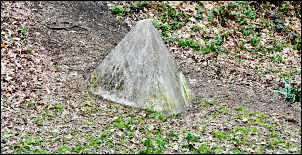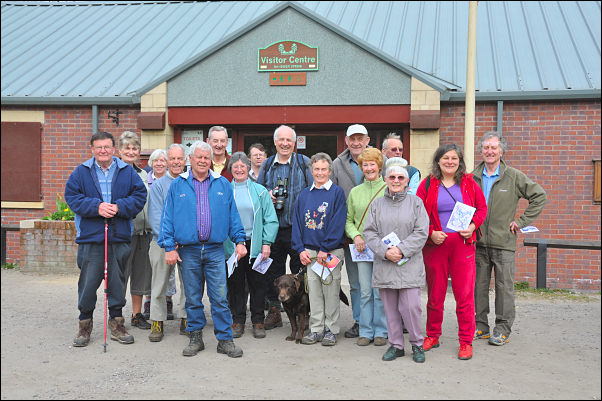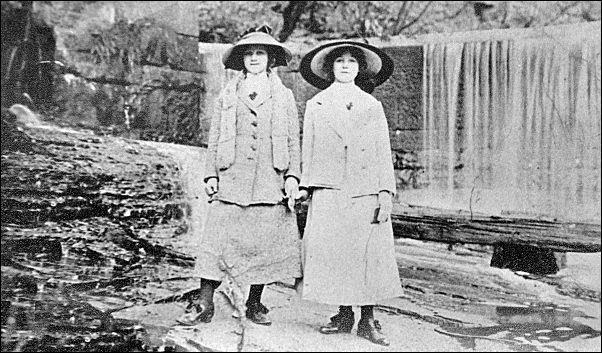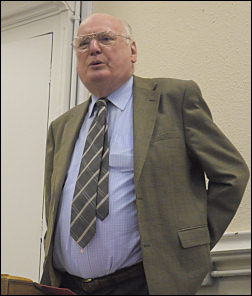|
Sun 18 Apr 2010
Geoff Bellis - Yarrow Valley Park walk. |
|
A fine day
greeted our guided history walk around the former industrial
area of Birkacre, now know as Yarrow Valley Country Park. Our
leader was Geoff Bellis who is a member of the society also
lives nearby so he was able to add a very personal view on the
commentary. We started with an introduction on the car park
outside the visitor centre. The name Birkacre derives from ‘the
field where the birch trees grow’. The area was the first
industrialised areas in Chorley and was also the site of one of
the world’s first factories in the modern sense. In 1398 John of
Coppull gave permission for a diversion of the River Yarrow to
run a corn mill but the first mention of the name Birkacre can
be found as early as 1250. |

A large concrete block marks the site
of the Dry Dam Colliery shaft. |
|
Over the
centuries the area has been the site of corn milling, cloth
bleaching, dying, printing and coal mining. We walked around the
area and lodges and Geoff showed us the sites of the various
mills, though little remains to show they ever existed. Sites of
the old mine shafts are more evident and mostly fenced off for
safety reasons. Geoff’s personal touch described an incident in
the mid 1950s when some unruly youths from Coppull, not Geoff!,
had removed a heavy garden roller from a Coppull garden and
rolled it down the hill in the direction of Birkacre. It
finished up in the River Yarrow and Geoff was able to point it
out, still sat there on the river bed 55 years later. |
|

Chorley Historical and Archaeological Society at the Visitor
Centre. |
|

May and Polly Riding at the weir. May married Frank Hearne and
emigrated to Wyoming in the U.S.A. |
|

Some of the many visitors to the weir. |
|
On a more serious note we were told of the very high fatality
rate in the coal mines both in the Coppull area and also
nationally. Near the ruins of primrose Cottages we were told of
a mining accident around 1850 when several children workers were
killed. At the far end of the walk we looked down on the large
weir across the river Yarrow. This was where the water was drawn
from the river to feed the various industrial processes. It was
also the gathering place for walkers and people enjoying picnics
etc. The ruins of Drybones Cottages could be seen through the
trees but recent arson attacks had now reduced it to a shell. It
was lived in by the Monks family until relatively recently.
Probably the most unfortunate incident was in 1779. Richard
Arkwright had leased a building the previous year and set up one
of World’s first manufactories, or mills as they were later
known. It housed a machine driven cotton mill employing 400
people and was able to produce a much improved output compared
with the hand weavers and their cottage industries. In Oct 1779
rioters attacked the building and burnt it to the ground.
Arkwright then decided to set up his new mill system in
Derbyshire.
Many of the houses and some mill buildings were evident up to
the 1950s but over the following decades they have been
demolished so that now only one house remains of the original
massive industrial complex.
Thanks to Geoff for bringing it all back to life during his
guided tour.
B.H. |
|
|
Tue 13 Apr 2010
David Brazendale – Life and Times of Benjamin Shaw – A First
Generation Cotton Operative. |
|
David’s first
visit to the society was to explain to us about the life and
times of Benjamin Shaw – a name not well known, if at all, to
people generally.
This was possible, as David said, because of Shaw’s book,
‘Benjamin Shaw’s Family Record’, published by the Lancashire and
Cheshire Record Society. As far as David is aware it is the only
one that documents an individual’s life from an agricultural
existence through the transition to an industrial one. It was a
self-imposed task to record his life.
Shaw was born in 1771 into a family of paupers that originated
in the Dent/Ravenstonedale area of Westmorland. At around the
age of 10 he was appointed to a weaver and would have added to
his family’s income by spinning stockings. During his childhood
he was also taught to knit and read but not write. |

David Brazendale. |

The Family Records of Benjamin Shaw Mechanic of Dent,
Dolphonholme and Preston, 1772-1841.
Edited by Alan G. Crosby - The Record Society of Lancashire and
Cheshire
|
|
As a product of
a positive campaign that encouraged the movement from country to
town the family, now consisted of 7 children, moved to
Dolphinholme, near Lancaster. Shaw, who was now 19, was taken on
as an industrial mechanic at 8 shillings a week.
Life here was still tough and tragedy stalked his family but
steady work, better wages and with housing provided it had more
appeal than an agricultural existence. He, however, suffered a
lifelong debilitating condition to his leg following an incident
at work.
Shaw’s book reveals him to be an inquisitive sort and he worked
on the invention and improvement of textile machinery.
By 1793 he had married a Betty Leeming, moved to the cotton
mills in Preston and had had a baby boy. This was to be the
first of 8 children. Shaw described his working life, first at
Watson’s Mill then to Horrocks’ Mill where he stayed for the
rest of his life.
He documented his efforts to teach himself to keep books and
arithmetic and his rise in wages as his skills were in more
demand. Sadly for him though were his troubled relationship with
Betty and of his increasing incapacitation due to his leg injury
and his efforts to obtain a cure. This led to its amputation
without anaesthetic in 1810.
David did not say to what age Shaw lived to. He did though mix
is talk with elements of humour and the tragic and revealed to
us was what a unique record Shaw left us of the trends
illustrated by the events of one family.
P Robinson. |
|